MAX9095ASD+T
Product Overview
- Category: Integrated Circuit (IC)
- Use: Signal Amplification and Conditioning
- Characteristics: High Gain, Low Noise, Wide Bandwidth
- Package: Small Outline Package (SOP)
- Essence: Amplifier IC for Signal Processing
- Packaging/Quantity: Tape and Reel, 2500 units per reel
Specifications
- Supply Voltage: 2.7V to 5.5V
- Operating Temperature Range: -40°C to +85°C
- Input Offset Voltage: ±1mV (maximum)
- Gain Bandwidth Product: 50MHz (typical)
- Input Bias Current: ±10nA (maximum)
- Output Current: ±30mA (maximum)
- Package Type: 8-pin SOP
Pin Configuration
The MAX9095ASD+T has the following pin configuration:
```
| | --| VCC OUT|-- Pin 1: Output --| IN- GND|-- Pin 2: Ground --| IN+ NC |-- Pin 3: Not Connected --| VEE NC |-- Pin 4: Not Connected --| NC NC |-- Pin 5: Not Connected --| NC SHDN|-- Pin 6: Shutdown --| NC VREF|-- Pin 7: Reference Voltage --| NC VCC |-- Pin 8: Supply Voltage |___________| ```
Functional Features
- High gain amplification of input signals
- Low noise operation for accurate signal processing
- Wide bandwidth for handling a broad range of frequencies
- Shutdown mode for power-saving when not in use
- Reference voltage for precise signal conditioning
Advantages and Disadvantages
Advantages: - High gain allows for amplification of weak signals - Low noise ensures accurate signal processing - Wide bandwidth enables handling of various frequencies - Shutdown mode saves power when not in use - Reference voltage provides precise signal conditioning
Disadvantages: - Limited to a maximum supply voltage of 5.5V - Input offset voltage may introduce slight inaccuracies
Working Principles
The MAX9095ASD+T is an integrated circuit designed for signal amplification and conditioning. It operates by receiving an input signal through the IN+ and IN- pins, which are then amplified with high gain. The amplified signal is available at the OUT pin for further processing.
The IC operates within a specified supply voltage range and temperature range. It has a low input offset voltage, ensuring minimal distortion of the input signal. The wide bandwidth allows for accurate amplification of a broad range of frequencies.
Additionally, the MAX9095ASD+T features a shutdown pin (SHDN) that can be used to put the IC into a low-power state when not in use. This helps conserve energy and prolong battery life in portable applications.
Detailed Application Field Plans
The MAX9095ASD+T finds application in various fields where signal amplification and conditioning are required. Some potential application areas include:
- Audio Systems: Amplifying audio signals for speakers or headphones.
- Instrumentation: Signal conditioning in measurement devices.
- Communication Systems: Amplification of signals in wireless communication systems.
- Medical Devices: Signal processing in medical equipment such as ECG monitors.
- Industrial Automation: Amplification and conditioning of sensor signals in control systems.
Detailed and Complete Alternative Models
- MAX9096ASD+T: Similar to MAX9095ASD+T with enhanced specifications.
- AD8221ARZ: Precision instrumentation amplifier with low noise and high gain.
- LM358N: Dual operational amplifier with wide supply voltage range.
These alternative models offer similar functionality to the MAX9095ASD+T and can be considered as alternatives based on specific requirements.
Word count: 445 words
Senaraikan 10 soalan dan jawapan biasa yang berkaitan dengan aplikasi MAX9095ASD+T dalam penyelesaian teknikal
Sure! Here are 10 common questions and answers related to the application of MAX9095ASD+T in technical solutions:
1. What is the MAX9095ASD+T? The MAX9095ASD+T is a high-speed, low-power operational amplifier (op-amp) designed for use in various technical applications.
2. What is the voltage supply range for the MAX9095ASD+T? The MAX9095ASD+T operates with a voltage supply range of +2.7V to +5.5V.
3. What is the typical gain bandwidth product of the MAX9095ASD+T? The typical gain bandwidth product of the MAX9095ASD+T is 50MHz.
4. Can the MAX9095ASD+T be used in single-supply applications? Yes, the MAX9095ASD+T can be used in both single-supply and dual-supply applications.
5. What is the input voltage range of the MAX9095ASD+T? The input voltage range of the MAX9095ASD+T extends from the negative supply rail to the positive supply rail.
6. Is the MAX9095ASD+T suitable for low-power applications? Yes, the MAX9095ASD+T is designed for low-power operation, making it suitable for battery-powered or energy-efficient applications.
7. Does the MAX9095ASD+T have built-in protection features? Yes, the MAX9095ASD+T includes built-in protection features such as short-circuit current limiting and thermal shutdown.
8. What is the output voltage swing of the MAX9095ASD+T? The output voltage swing of the MAX9095ASD+T typically extends to within a few millivolts of the supply rails.
9. Can the MAX9095ASD+T drive capacitive loads? Yes, the MAX9095ASD+T is capable of driving capacitive loads up to 100pF without any external compensation.
10. What are some typical applications for the MAX9095ASD+T? The MAX9095ASD+T can be used in a wide range of applications including active filters, data acquisition systems, medical instrumentation, and communication systems.
Please note that these answers are general and may vary depending on specific design requirements and conditions.


